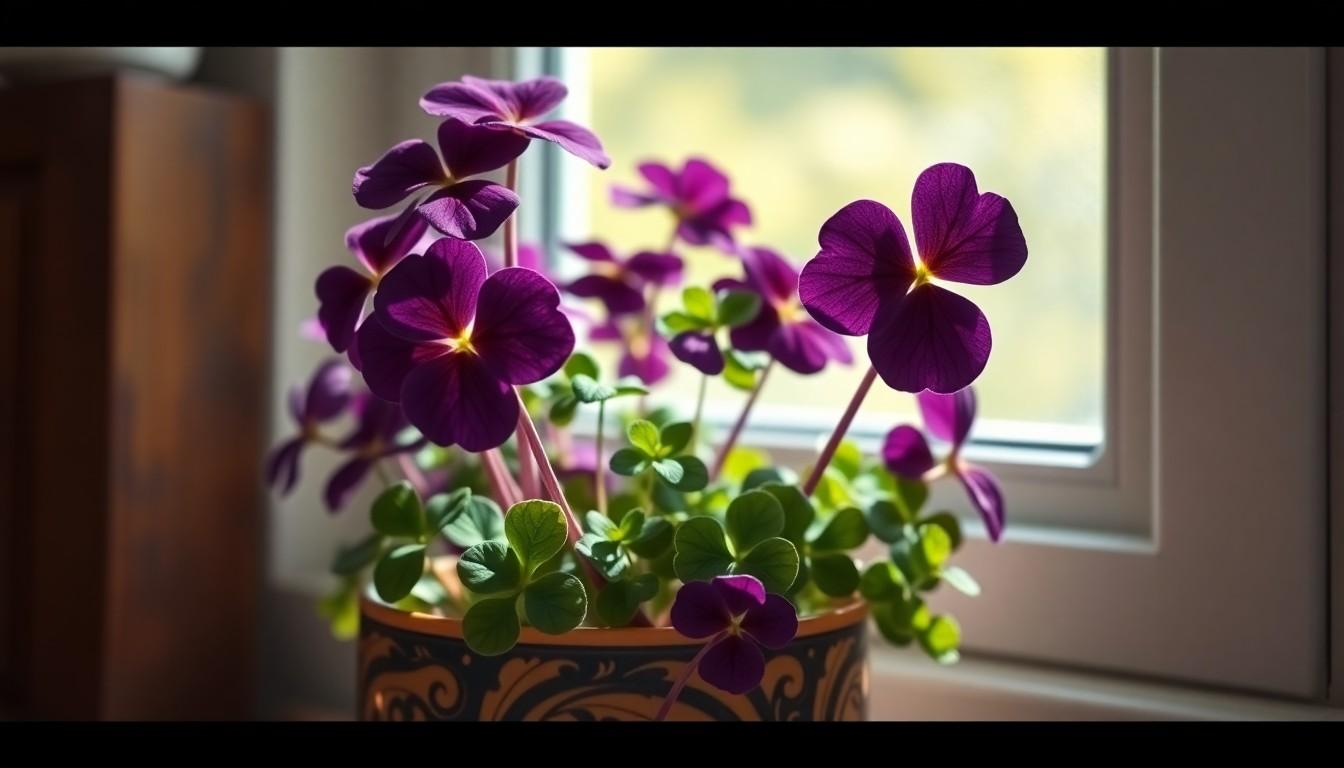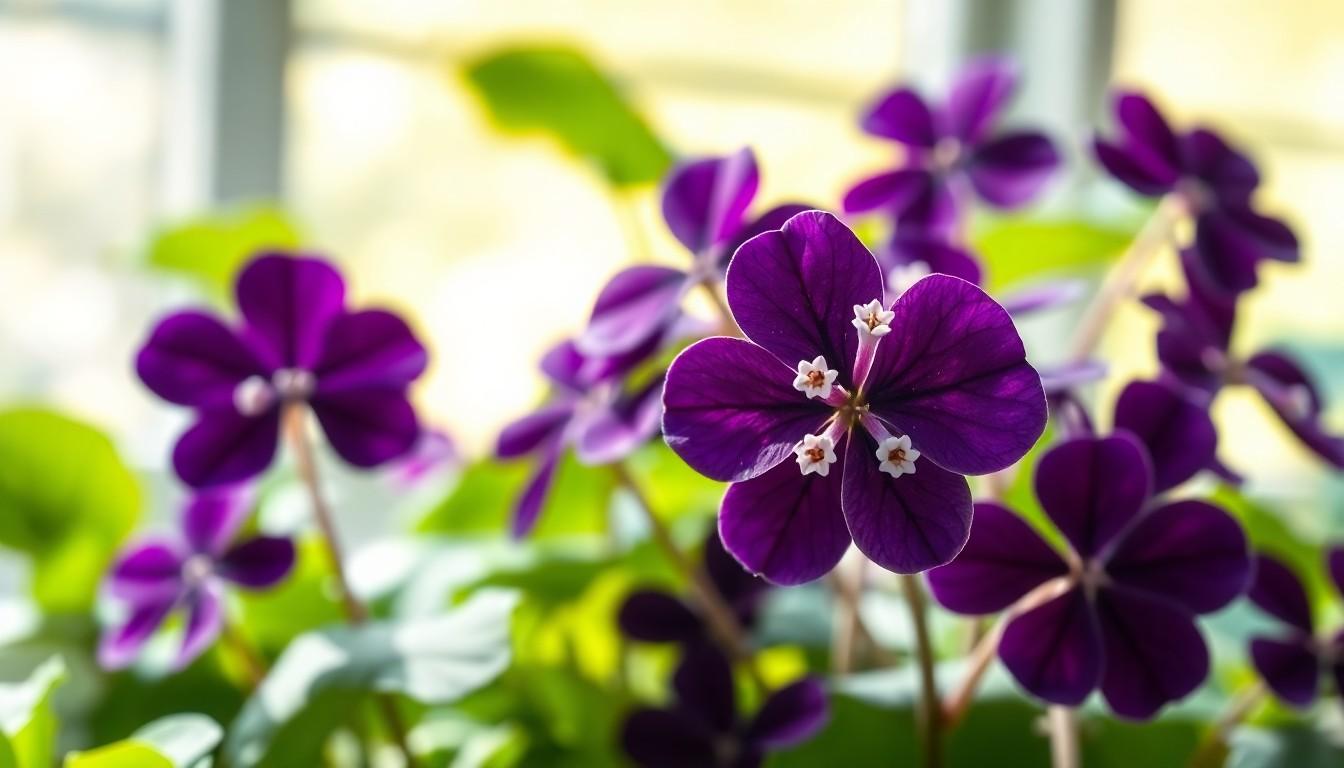If you’re looking to add a dash of charm to your home, the purple shamrock plant is a must-have. With its vibrant, clover-like leaves and delicate purple flowers, it’s like having a little piece of Ireland sitting on your windowsill. But don’t let its beauty fool you; this plant requires a bit of TLC to thrive.
Understanding Purple Shamrock Plants
Purple shamrock plants stand out with their unique leaf shapes and colors. These intriguing plants not only enhance aesthetic appeal but also bring a touch of nature indoors.
Characteristics of Purple Shamrock
Purple shamrock features clover-like leaves that display a rich, dark purple hue. Each leaf consists of three leaflets, giving it a distinct look. It reaches heights of 8 to 12 inches and spreads about 10 to 12 inches across. Flowers emerge in clusters, adding delicate white and purple hues during its blooming period. This plant undergoes a natural dormancy phase, which typically occurs in late winter. During this phase, it loses leaves and appears dormant, only to rejuvenate in spring.
Common Varieties
Several varieties of purple shamrock capture attention. The most popular, Oxalis triangularis, showcases striking purple foliage and blooms in spring. Another variant, Oxalis regnellii, displays green leaves with purple undersides, complementing its striking purple flowers. Oxalis deppei, known for its vivid green leaves and white flowers, offers a bright contrast. The diversity in shapes and colors makes these plants interesting choices for home decor. Choosing the right variety personalizes space while ensuring that each plant’s unique traits shine.
Essential Care Tips for Purple Shamrock

Caring for a purple shamrock plant involves understanding its specific needs. Proper light, watering, and soil play a crucial role in its health and growth.
Light Requirements
Purple shamrock thrives in bright, indirect light. Direct sunlight can scorch its delicate leaves. Ideally, place it near a window that receives filtered sunlight for best results. In low-light conditions, the plant may become leggy and lose its vibrant color. During the growing season, the plant appreciates exposure to light for around six hours daily. Consider rotating the pot weekly to ensure even growth on all sides.
Watering Guidelines
Watering must be done with care to avoid over-saturation. Allow the top inch of soil to dry out between watering sessions. During the growing season, a weekly watering schedule usually suffices. Reduce the frequency during the dormancy phase in late winter to prevent root rot. If yellowing leaves appear, it may indicate overwatering, while wilting could signal a need for more moisture. Always use room-temperature water to maintain consistent plant health.
Soil Preferences
Well-draining soil is essential for a healthy purple shamrock. A mixture of standard potting soil combined with perlite or sand works well for optimal drainage. Avoid soil that retains excessive moisture, which can harm the roots. Ideally, the soil pH should range between 6.0 and 7.0 to facilitate proper nutrient absorption. Repotting every couple of years helps provide fresh nutrients and a suitable environment for growth.
Propagation Techniques for Purple Shamrock
Purple shamrock plants can be propagated effectively using two main methods: division and stem cuttings. Each technique caters to different preferences and experiences.
Division Method
Division offers a straightforward approach to propagate purple shamrock. In early spring, gently remove the plant from its pot, ensuring minimal damage to the roots. Separate the tubers, making sure each division has healthy roots and foliage. Replant the divisions in well-draining soil, placing them in bright, indirect light. Water the newly divided plants thoroughly, ensuring the soil remains moist but not soggy. This method promotes quick establishment, allowing for vibrant growth in a short time.
Stem Cuttings
Stem cuttings present another viable propagation method for purple shamrock. Choose healthy stems with multiple leaves. Cut segments approximately 4 to 6 inches long, focusing on stems with leaf nodes. Place the cuttings in a glass of water or directly in moist potting soil. For water propagation, ensure the nodes remain submerged, replacing the water every few days. When roots develop, typically within two to three weeks, transplant the cuttings into individual pots. Utilize bright, indirect light to encourage robust growth while monitoring soil moisture levels.
Common Problems and Solutions
Identifying common issues with purple shamrock plants helps ensure their vitality. Addressing pests and environmental stress factors allows for better care.
Pests and Diseases
Aphids, spider mites, and mealybugs frequently affect purple shamrock plants. Checking the undersides of leaves helps spot these pests early. If found, applying insecticidal soap or neem oil effectively removes them. Fungal infections can occur due to overwatering. Noticing yellowing leaves points to moisture-related diseases. Reducing watering until the soil dries out can limit these issues. Ensuring healthy air circulation around the plant also aids in preventing future outbreaks.
Environmental Stress Factors
Improper light levels contribute to stress in purple shamrock plants. Insufficient light results in leggy growth, while too much light causes leaf scorch. Positioning the plant in bright but indirect light supports healthy development. Temperature fluctuations can additionally affect plant health. Keeping temperatures between 60°F and 75°F promotes stability. Also, handling humidity with caution is important; dry air can lead to wilting. Using a humidity tray or misting the leaves occasionally assists in maintaining appropriate levels.
Conclusion
Caring for a purple shamrock plant can be a rewarding experience. With its stunning foliage and unique blooms it adds charm to any space. By providing the right light conditions proper watering techniques and well-draining soil this plant can thrive beautifully.
Regularly checking for pests and adjusting care during dormancy ensures ongoing health. Whether expanding a collection through propagation or simply enjoying its beauty the purple shamrock remains a delightful choice for plant enthusiasts. With a little attention it can flourish and bring joy for years to come.

